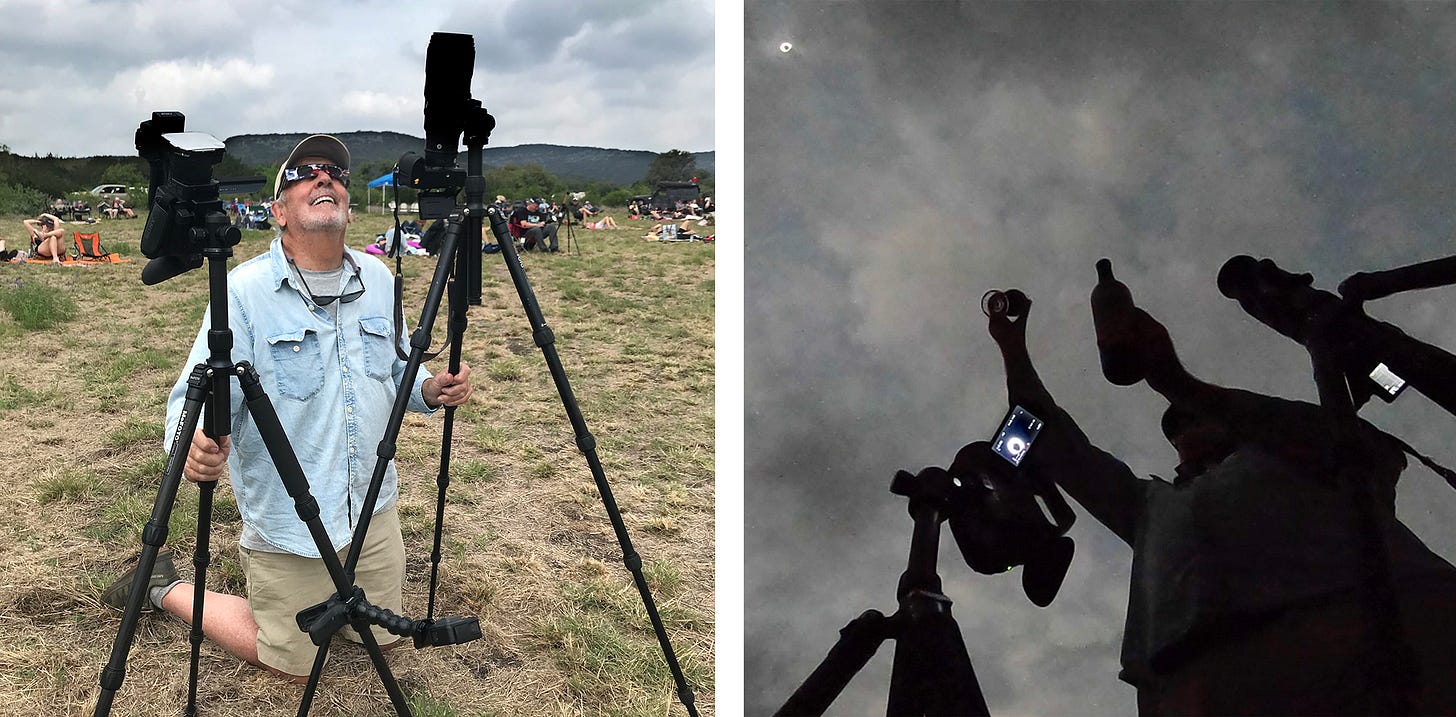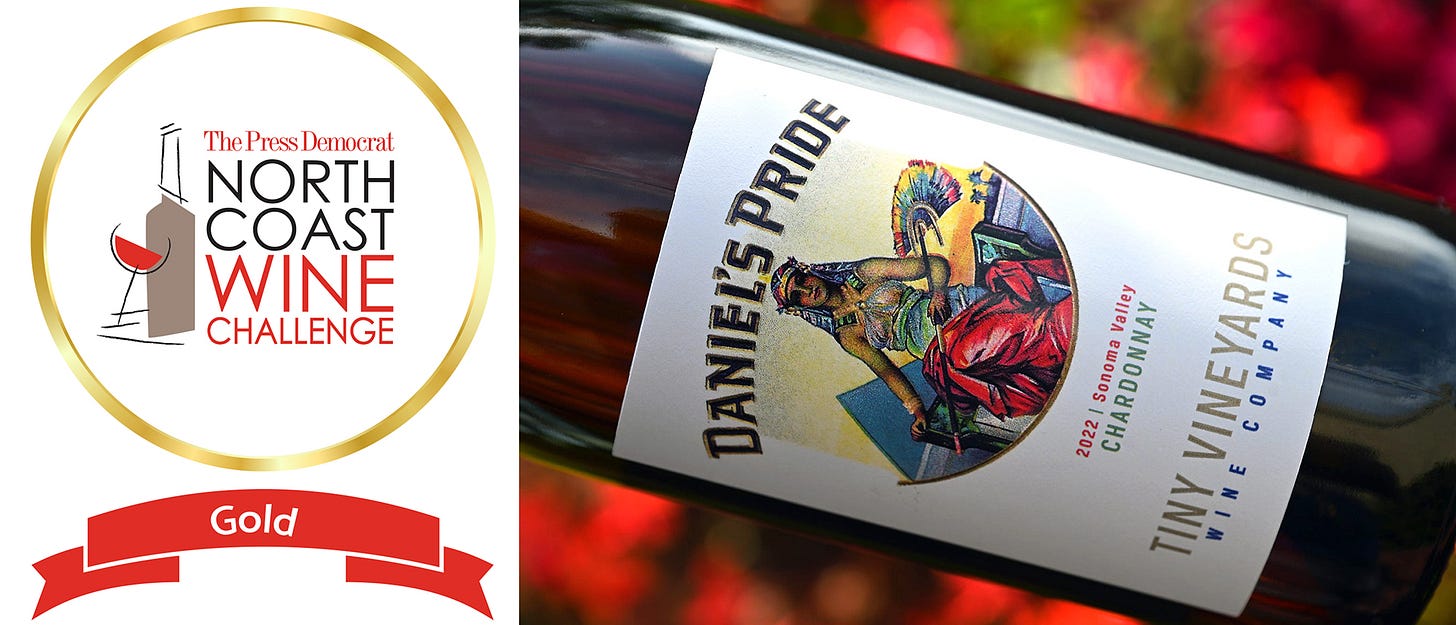First Gold Medal, and Eclipse at Last
Bling on a bottle and fire in the sky. The last week has been a doozy!
Too much of a good thing can be wonderful. —Mae West
Every hour toiled and dollar spent is suddenly worth it
With the commercial wine competition and awards season just getting underway I’m thrilled to announce—while being more than a little dumbstruck!—how well the first professional vintage of Tiny Vineyard Wine Company is doing. We’ve only received results from two competitions so far, and already we’ve won some bling!
The most exciting is a Gold Medal and 93-point designation for our Daniel’s Pride Chardonnay in the North Coast Wine Competition. This is a very respected, industry-driven wine competition for the best of Northern California wines (Napa, Sonoma, Lake, Mendicino, Marin, etc.), so it’s especially gratifying. And Gold Medal winners are invited to pour their wines at the North Coast Wine & Food Festival, a gustatory extravaganza on June 15 in Santa Rosa, which has drawn over 1,200 attendees in the past. Visit us there for a taste, or go to tinyvineyards.com and secure a few bottles before the word gets out!
In addition, we won a Silver Medal for our Rose of Zinfandel and a Bronze Medal for our Eclipse Malbec in the same competition.
We also fared pretty well in the Los Angeles International Wine Competition, winning Silver Medals for our Eclipse Malbec, our Rose of Zinfandel, and our Requisite Red Blend. To top that off, we also won Gold Medals for Packaging and Label Design for our Eclipse Malbec bottle and our Requisite Red bottle!
For a winemaker, entering a commercial wine competition and getting some recognition can be extremely rewarding, both personally and financially (as regards increased sales), but it can also be a bit of a crap shoot. Not every wine is right for every contest. Each competition seems to have its own focus, picks its judges in a certain way, and looks for its own variety and style favorites—often regionally influenced. And entering these commercial competitions is expensive, with entry fees averaging around $100 per wine, plus the cost of shipping. I picked a half-dozen or so competitions for this year—which is all the budget would allow—and I’m excited to see how we might do. So far so good!
Finding closure with the eclipse
Not an easy thing to do. Especially since the initial anticipation began almost five years ago at the last accessible major eclipse, in Argentina, where I would shoot the now iconic photograph that is featured on the label of my current Eclipse Malbec—a wine I began making over three years ago. And within that time there were those 18 months of élevage in the barrel, and another 12 fretful months in the bottle, punctuated with the most surprisingly responsive marketing campaign ever.
But those stories have all been told, here, here, here, here, and here. Now, it was down to actually witnessing the eclipse that had inspired it all.
We headed to the tiny south Texas town of Utopia despite dire weather forecasts for severe thunderstorms and totally overcast skies, which had us second guessing ourselves and almost canceling just hours before our flight was scheduled to leave northern California. But how could we not go? I think if the Plagues of Egypt had been descending on Utopia—there’s a phrase I never thought I’d write!—we still would have gone.
Deb and I flew to San Antonio, spent a short, sleepless night worried about all the eventualities, then drove west early the next morning, under broken skies with angry clouds, through Bandera—Cowboy Capital of the World and home to the first newspaper to print a story about my Eclipse Malbec—and into the Texas Hill Country in search of the Indian Blanket Nature Ranch to meet up with my old pal Michael Aisner and his crew of eclipse chasers.
Michael and I saw our first eclipse together in Montana in 1979. This one in Texas would be my sixth. It would be his fourteenth!
It would be Deb’s third eclipse, and I have to say the level of angst and outright pessimism over the odds of being “clouded out” seemed to be in direct proportion to how many lead-ups to a total solar eclipse one had previously experienced. Deb was becoming disillusioned at our chances. I was certainly more hopeful, having never been clouded out in my five previous shadows. And Michael was the picture of upeksha, all inner peace and tranquility.
Of course, that didn’t exactly make sense given the weather forecast, but I had spoken to a local rancher who had grown up in the area and he promised me the clouds would clear by 1:30pm, the time totality was scheduled to begin. “I’ve lived here for over forty years and I’m telling you those weather predictions are never accurate for this part of the hill country. Just you wait and see.”
From his lips to God’s ears.
And sure enough, around noon the clouds began to break up and increasing areas of blue sky appeared. This continued until 1:00pm or so as we all gathered in a small meadow and set up cameras and telescopes and made our spaces on the ground to lay back and enjoy the eclipse. The mood was festive, we had beat the weather and were about to see one of the most spectacular sights in nature.
Then suddenly the wind picked up and the clouds began to gather again. We could still see the almost fully eclipsed sun—intermittently—through the new cloud cover, but for shorter and shorter glimpses. As the final minutes ticked away before the start of totality, so did the last of the blue sky, and we witnessed the moon’s shadow rushing towards us as a blanket of gloom on the underside of a now totally overcast sky.
“Oh no, this can’t be happening,” I remember saying out loud as I searched the clouds for any sign of an opening or even just thinner coverage. Then like a switch we were enveloped in darkness. Much more so than any previous eclipse I had witnessed. Darkness truly like night. The kind you have to let your eyes adjust to before you can see anything. Totality had begun and we now had 4 minutes and 23 seconds for the clouds to clear or this whole thing was going to be a bust.
Damn.
For over three minutes we all stared at the ominous grey dome above in quiet disappointment. Then suddenly a brighter spot appeared and a tiny black hole—like a paper punch out of the sky—appeared, surrounded by an angry corona dancing in fiery spectacle amongst the swirling clouds. A loud guttural shout went up from our crowd, punctuated with screams, cries of happiness and applause. We were like a microcosm of a sold-out crowd in a soccer stadium witnessing the winning goal. Then just as suddenly, after only a few astounding seconds the eclipse disappeared again into the grey miasma. And along with it you could feel our euphoria slip away.
A few moments passed—maybe minutes, hours, years?—and the beast returned. And this time it stayed. For the rest of totality. For over a minute it broke through thinner overcast that looked like smoke and refracted off thicker clouds in flashes of light so bright they hurt. All to the sound track of our utter amazement. Then it was over in a final flare they call the diamond ring. And we all were cleansed. Changed forever. Sated.
We all agreed that a single minute of viewing totality through the dramatic clouds, like we had just witnessed, was even more wondrous than four-and-a-half-minutes of totality against a clear sky.
A fitting ending to a very long, improbable journey making a wine and honoring its story.


To experience our glorious minute of totality in Utopia, Texas, watch the video above. If you are prompted for a password, it is: Utopia2024 (case sensitive).






So fun to follow your journey Joe! Keep up the great work 👍
FABULOUS video! Thank you, Joe.